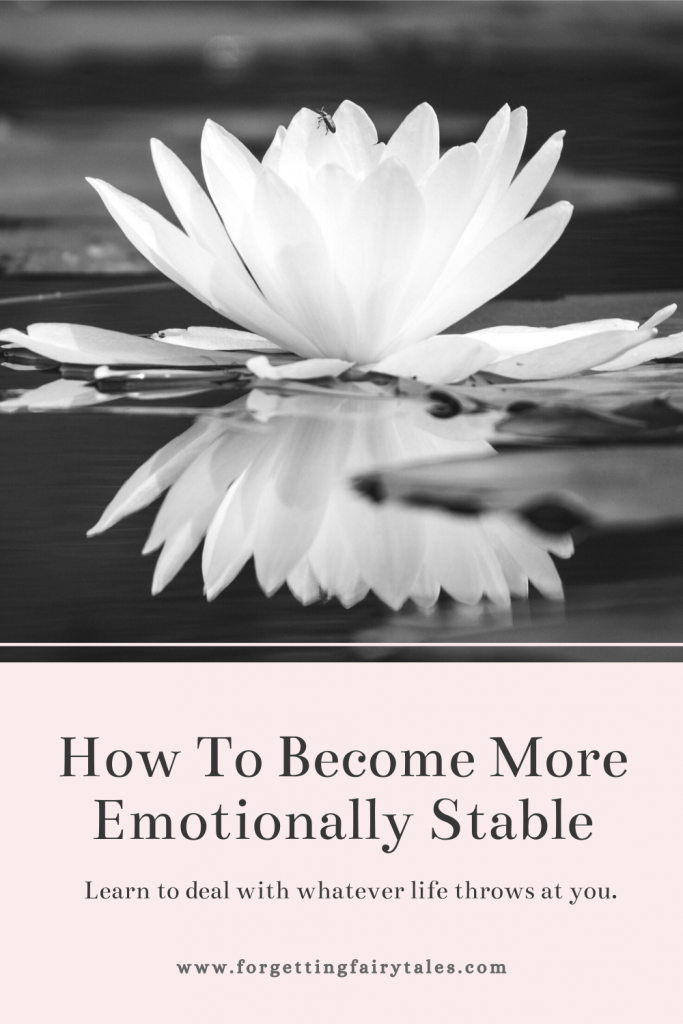Learning how to become emotionally stable is fundamental for pushing through the hard times, and actually keeping your sanity! See, emotional stability is not about ignoring or suppressing your emotions. Your emotions are valid – positive or negative, they are telling you something valuable.
Instead, emotional stability is more about being able to understand your emotions and feel them, without letting them take over. Emotional stability enables you to cope in stressful, painful or difficult situations, to push through the challenges of life and know that you will be okay.
How To Become Emotionally Stable
So how do you become emotionally stable? Where do you actually start? It can seem a little overwhelming, I know.
There’s a lot you can do and try to build your emotional stability. Just remember – you don’t have to master this all in one go. It will actually be a long (and ongoing) learning process, taking consistent effort as life deals you new cards and challenges.
So let’s start from the top, with what you actually need to become emotionally stable.
Step 1: Feel Your Emotions
Allow yourself to feel your emotions, and express the way you feel.
The worst thing you can do to try to gain emotional stability is block out your emotions. It only covers over the cracks and prolongs the pain.
So if you want to feel good again – or at least ‘okay’ – you need to give yourself some time to feel what you are feeling.
Look at the emotions that are within you, why they are there and the thoughts that are driving them. Don’t bottle them up.
Whether it’s talking to someone, writing about it in a diary, or expressing your emotions through something like dance, art of music – this is going to really help.
See, whether you like it or not, you can’t get around the painful part of feeling your emotions. So the sooner you do this, and face up to them, without seeing them as ‘bad’, the faster you can become emotionally stable again.
Step 2: Challenge The Thoughts Behind Your Emotions
Challenge your negative thoughts, question your rationale. This is how you can better beat the negative emotions that come as a result of them – that may not be entirely necessary.
When you start to feel your emotions, you’ll begin to notice some that are fully justified, but also some which are a little irrational. The irrational ones are driven by thoughts that aren’t even true.
It’s like if you’ve gone through a breakup – you might feel worthless, with thoughts about not being good enough. This is a negative thought you would want to challenge in order to gain better emotional stability.
The goal is to stop stirring up bad feelings that come from thoughts that aren’t accurate. Instead, you want to destroy the inaccurate thoughts, before they can do more damage to your emotional state and sense of worth.
Awareness is therefore key. Spot it. Challenge it. Stop it. You see?
Step 3: Change The Way You See The Situation
In order to become emotionally stable, you want to change the way you see things, shift your perspective to look at it in more empowering ways.
It’s important to not to be too closed-minded or black and white when it comes to dealing with different situations. See, when something uncomfortable happens, the initial shock gives us tunnel vision…
Example of a Perception Shift:
Let’s carry on from the breakup example where you might see it as the end of the world…
Your heart has broken, you thought that person was ‘the one’ and you have no idea how you are going to find happiness again after this. However, you have to change the way you see it, from a tragedy to an opportunity.
- Look for the things you can still be grateful for.
- Look for the ways in which things could be better now.
- Think about what you could get excited for.
- Think about how you could choose to see it.
- Then decide to choose to see it that way… and actually believe it!
By shifting your perspective and becoming more open-minded to the positives of a negative outcome, you’re naturally more emotionally stable, because you don’t see things with as much pain or intensity.
Here, have a read of this for how to accept the things you don’t want to – that will help a lot too. Click here.
Step 4: Change Your State
Calm your mind, sooth it, take care of it. The more worked up you are, the less rationally you can think.
So before we continue with this article, I highly recommend you click here…
It will give you the strong foundations you need to implement these emotional stability techniques.
Step 5: Take Positive Action
The final step to becoming more emotionally stable comes in taking action (like most things!) Look at what you can do, right now, in this moment.
Try to build together a little plan. Even if it’s just a plan for how you’re going to get through the morning, afternoon, or day. Start small. Baby steps.
Think about what would make the situation more manageable. Look for how you can better deal with your emotions, right now, in that moment.
I’m going to give you more suggestions for dealing with your emotions further down in this article. But think about what’s helped you in the past, what seems semi-bearable right now, or that you think actually may be pretty good for you.

Five Strategies For Building Emotional Stability
I want to run through a few strategies for emotional stability now – things you can actually do which will help you become emotionally stable.
These techniques are going to enable you to better deal with your emotions. To calm down, to think clearly again and become more grounded.
1) Mental Visualisation
So let’s say you’re in a situation you really don’t want to be in right now, like a breakup for example, with nights suddenly spent alone and nothing but past memories with this person, going around and around in your head.
How do we deal with this? Well, mental visualisation is certainly something well worth trying. In a nutshell you just have to:
- Picture a scene that is totally different from the one playing out in your life right now.
- Visualise a scene that is calm, serene and where you feel in full control. Play gentle music in the background – perhaps the sounds of waves – and focus fully on that and that alone.
- Follow the flow of the sounds and get away from reality until you have significantly changed your state.
When you do then return to the present moment, you’ll feel a lot calmer. With a clear mind, you’re more able to make far better decisions, and actually take some positive action, which will only build on the better state that you now find yourself in.
2) Physical Grounding
Next up I want to talk about physical grounding for helping you to become emotionally stable. If you’ve never tried it before, it’s a bit of a different concept, but bear with me okay?
In a nutshell, physical grounding its when you bring your focus to what is happening to you physically, either in your body or in your surroundings – instead of being trapped by the thoughts in your mind.
So for example, you might get up and walk around, taking the time to notice each step as you take one, then another. You might sit and listen, making a mental note of the sounds you can hear around you, before branching it out further or wider.
Or you may even just stroke your finger over the palm of your hand, noticing the texture, noticing the sensation it gives to your hand. You see?
3) Become Your Own Best Friend
Another great habit for emotional stability is learning to self-sooth.
We all have voices in our heads. They tell us things which can be constructive or destructive. Work on letting the positive voice shine through.
Encourage yourself, support yourself, be kinder to yourself. Say the things you’d say to your friend, or you know that your Mum would say to you.
4) Focus On Your Breathing
When you feel yourself getting all worked up, a fast and effective way to calm down is through breath control. Healthline recommends these calming, breathing exercises.
From breath focus to resonate breathing, pranayama to nadi shodhana – it can be as simple or advanced as you need. There are lots of different options, suitable for anyone and everyone. I think you’ll be surprised of the impact it can have.
Once you learn what you need to, and start to practice it daily, you then have the power to stabilise your emotions in almost any situation.
5) Learn To Meditate or Become More Mindful
I couldn’t give you a list for how to become emotionally stable, without the classic recommendations of mindfulness and meditation! The thing is, I want to break the preconceptions around it a little, before you rule it out.
See, mindfulness is a powerful tool that creates space between an action and your reaction. Meditation trains the brain to process emotion differently. Both are therefore invaluable for taking you away from the overwhelming emotions in that moment, instead shifting your state and clearing your mind.
It’s not all airy-fairy nonsense for a ‘certain type of person.’ Mindful living and meditation practices can be used by anyone. You don’t have to sit for hours on end or train yourself up.
Short, simple Guided Mindfulness Meditations can easily do the job. You might like to start with something like this.

Things You Can Do To Become Emotionally Stable
What else can you do to become more emotionally stable? Well aside from the recommended strategies above, you can also try simple things in the heat of the moment, to calm you down a little bit. Things like…
- Taking a hot bath to ease the emotional tension.
- Getting out amongst nature. Going for a walk, or sitting out in a park / garden for a little while.
- Switching off your phone or having a digital detox for a few hours.
- Doing a workout and releasing your frustration through activity.
- Losing yourself in a hobby – something that you enjoy.
- Finding your flow, distracting yourself with a project that engulfs you, until you become more level-headed again.
- Getting lost in music that you love. (Just don’t go for a sad song playlist!)
- Sit in silence and stillness, giving your mind chance to breath… or process what you need even.
- Have a cuddle (animals or humans will work!) The close contact helps to create a a more calm, stable disposition.
- Spending your time with good people. If you keep surrounding yourself with toxic and emotionally unstable people, that’s exactly who you’ll become. Be around people who will listen to you, not judge you, actually support you. It makes the world of difference.
If you’re still struggling with your emotions, and processing your feelings around a certain situation, don’t be afraid to ask for help – whether that’s from friends, family, a therapist or a coach. I actually offer coaching, click here for more on that.
Getting help to improve in the areas you’re struggling doesn’t make you weak. Quite the opposite actually. Knowledge is also power. So working through your issues with a professional, is only going to help strengthen you.
Why You Need To Work On Your Outlook To Become Emotionally Stable
What else makes a difference? How you feel about yourself.
The more secure you are in who you are, the less you will take things to heart and the better you will be able to deal with whatever comes your way.
You don’t need to take things personally. You also need to know that you are strong enough to get through anything and that each and every adversity is only shaping you into who you are (and who you want to be.)
As part of this, you may also need to review your outlook when it comes to life in general.
- It’s not healthy to live, always assuming the worst or waiting for the worst. That’s just negative and makes you feel the pain of a situation before it’s even happened.
- Having said that, it is important to be aware that things can go wrong, and often do go wrong. I mean, when has anyone’s life ever always gone to plan? It’s impossible! Bad things happen, to both good and bad people – because that’s the way of life.
If you want to become emotionally stable and remain calm in even the craziest of situations, you have to be aware that there’s a possibility of anything happening.
You don’t need to prepare for it or anticipate it, but you won’t be shocked about it because you know that life isn’t a fairytale and you’re going to face a fair few hiccups, always.
By knowing this, and being okay with it, it makes you far stronger and more resilient.

Prioritise Your Mental and Emotional Health
Science has proven that emotional stability will make you wiser, make you happier, enable you to learn things faster and better deal with anything that comes your way moving forward.
This is why it’s so important to become aware of how we react and respond in situations, and really put the time into learning how we can better deal with things, starting from how we feel within.
There will always be times when we are really tested in our life. But remember, each time we go through things that are painful, there’s a huge opportunity for growth. Use the tough times to make you stronger. Embrace whatever get’s thrown your way.
You can get through this, and you will.
For more support, encouragement and advice, subscribe to my blog below and I’ll notify you every couple of weeks with the latest nuggets of goodness! Like I said above, you may also like to check out my coaching.
Take care. Keep learning and growing.
Love,
Ell_xx

Recommended Reads:

